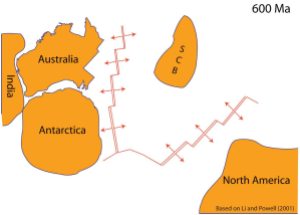Anyone who knows anything about New Zealand geology will know that it was once ‘part of Gondwana’. This is true, but how did it become a ‘part’? This is the origin of New Zealand in ‘deep time’.
The question was addressed by researchers Li and Powell in 2000. While no-doubt much has been learned since this time, I am unaware of any fundamental changes to what they proposed. Their paper traced the history of Rondinia – a somewhat hypothetical of the supercontinent that predated the supercontinent of Pangaea (formed of Gondwana and Laurasia).
Pre-Gondwana, the world had a very different geography. Piecing together Gondwana was, in simple terms, a matter of fitting together the modern continents. But in Rondinian times – large portions of today’s continents simply did not exist. On top of that, it seems that the continental fragments that did exist were grouped in ways that could not be guessed by simply looking at today’s globe.
Li and Powell proposed that the eastern part of Australia (roughly the eastern quarter) did not exist around 760 Ma (million years ago). Instead, there was a continuous continental connection with a part of what is now China – and beyond that, North America. To the south, Australia was firmly connected to Antarctica.

The basic structure of the supercontinent of Rondinia around 760 Ma. The South China Block (SCB) lies to the east of Australia – which does not yet have its most eastern quarter.
Rifting broke the region up, so that by around 600 Ma the Chinese and North American blocks were separated by what was effectively the Pacific Ocean. At this stage, the eastern margin of Australia/Antarctica and the western of the Chinese block were passive. That is, they were not geologically active, but resembled the margins of the Atlantic Ocean today.

By 600 Ma rifting had separated the South China Block and North America from the Australia-Antarctica region. This rifting formed the Pacific Ocean.
This all changed around 505 Ma, as another Chinese block began to move towards Australia. Simultaneously the east coast of Australia/Antarctica became an active margin. This involved the formation of a deep-sea trench/subduction system and an associated chain of volcanoes. It marks the birth of New Zealand as well as the eastern quarter of Australia. New Zealand’s oldest rocks are about 550 Ma (mid Cambrian). They are partially the remains of that volcanic island arc and also contain limestones that have a variety of fossils, including trilobites. These lived in the shallow seas around the volcanoes – which lay (another surprise!) in the Northern Hemisphere.

Around 505 Ma the North China Block approached from the east and an active margin with a trench/arc formed.
Li and Powell (2001) proposed that proto-New Zealand was born to the south of Tasmania and off the coast of Victoria land in Antarctica and subsequent research supports this. Gutjahr et al. (2006) had a close look at the cobbles in some of New Zealand’s Cambrian conglomerates – and concluded they were exotic to New Zealand. They couldn’t pinpoint where they came from, but it seems reasonable that some of them may have come from what is now Antarctica. Bradshaw et al. (2009) also located proto-New Zealand “to the south of northern Victoria Land, probably in the region of the southern Ross Sea”. This was in the context of a back-arc basin that was being squeezed against a continental margin, and being rapidly filled by sediment from both the continental side and the arc side.
At about the same time as New Zealand was born, Gondwana too, had achieved its basic structure.
References
Bradshaw , J.D., Gutjahr, M., Weaver, S.D., & Bassett K.N. 2009. Cambrian intra-oceanic arc accretion to the austral Gondwana margin: constraints on the location of proto-New Zealand, Australian Journal of Earth Sciences: An International Geoscience Journal of the Geological Society of Australia, 56: 587-594
Gutjahr, M., Bradshaw, J.D., Weaver, S., Münker,C., and Ireland, T. 2006. Provenance of Cambrian conglomerates from New Zealand: implications for the tectonomagmatic evolution of the SE Gondwana margin. Journal of the Geological Society 163, 997-1010.
Li, Z.X. and Powell, C.McA. 2000. An outline of the palaeogeographic evolution of the Australasian region since the beginning of the Neoproterozoic. Earth-Science Reviews 53: 237–277.


